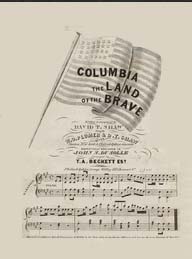
Red White and Blue
The great musician and conductor of the Philadelphia Orchestra, Eugene Ormondy, was often quoted as saying, "To please an audience, you must perform something old, something new, and something for them to whistle on the way home." Over the years, many people have often heard me say the same thing in terms of parades and other public performances. "Yankee Doodle" obviously fits into the "whistle category," as does "Girl I Left Behind Me," "Garry Owen," and "Rosin the Beau," but there aren't too many other tunes that really apply. They can all be traced back to prior to the American Revolution. Another tune of probably more recent vintage is "Columbia, the Gem of the Ocean," known during the War Between the States as "Red, White and Blue." Not only will it be whistled on the way home, but a majority of the public will remember and sing the first six words and, consequently, one of its numerous titles.
The origins of the tune are about as vague as it can get: Its first publication that I can find was in 1843 by George Willig, a publisher who, coincidentally, wrote "The Compleat Tutor for the Fife" in 1805. He is sometimes credited with composing "Red, White and Blue" but in 1843 was quite long in the tooth and these stories are probably untrue. When he published it as "Columbia the Land of the Brave," the composition was credited to David Taylor Shaw and the arrangement to Thomas a'Beckett.

However, before the dust had sufficient time to settle, they both were claiming creative rights to the song. As one story goes, Shaw wrote the melody and asked a'Beckett to modify the lyrics in some way. It was all done when Shaw, a singer, and a'Beckett, an actor and musician, were both situated at the Chestnut Street Theater in London. This was a time when Britannia ruled the waves, with the largest navy in the world, and one wonders why two Brits would be creating a patriotic American song to be performed at a benefit in London. Yet, the British version, "Britannia, the Pride of the Ocean," wasn't published until 1852, and then as the claim of one Stephen Joseph Meany, with no credit whatsoever to the other two! To compound the confusion, Shaw is sometimes described as an actor at the Chestnut Street Theater in Philadelphia!
During the Civil War years, the song was published under the names of both Shaw or a'Beckett, but rarely together. One additional point of confusion: I have seen records stating that a'Beckett was born in 1750, which would have made publisher George Willig, born in 1764, a youngster by comparison. a'Beckett would have been 93 years of age at the time of the song's publication.
During the years prior to the War for Independence, a common term used to describe the thirteen colonies was "Columba," honoring Christopher Columbus, who some say didn't discover America. It later evolved into "Columbia," which was superseded in the Declaration of Independence by "America." This "Columbia" is the term referred to in the naming of the District of Columbia. America was named after Amerigo Vespucci, a Florentine cartographer who may or may have not died ten years before Columbus may or may not have discovered the New World.
Sometimes, I begin to research an interesting article and wind up taking leave of my senses. That's the way it frequently is when it comes to historical music. Let me sum it all up by saying, here it is...a great old tune appropriate for Civil War reenactors...a real crowd pleaser! Play it in a parade and they will whistle it on the way home and maybe even sing the first six words, which aren't "Red, White and Blue." I haven't a clue as to where that name came from.

ŠE.W.Boyle, 2003 (All Rights Reserved)